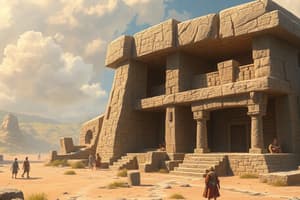Podcast
Questions and Answers
Which of the following materials were commonly used in prehistoric architecture?
Which of the following materials were commonly used in prehistoric architecture?
- Plastic and rubber
- Glass and brick
- Steel and concrete
- Animal skins (correct)
What marked the transition from a nomadic lifestyle to settled communities around 9000 BC?
What marked the transition from a nomadic lifestyle to settled communities around 9000 BC?
- Introduction of farming and agriculture (correct)
- Construction of large monuments
- Development of written language
- The use of metal tools
Which structure is associated with nomadic hunter communities during the Paleolithic period?
Which structure is associated with nomadic hunter communities during the Paleolithic period?
- Igloo
- Rock caves (correct)
- Hogan
- Trullo
During which period did early humans begin to settle year-round?
During which period did early humans begin to settle year-round?
Which feature is NOT typically associated with prehistoric burial rituals?
Which feature is NOT typically associated with prehistoric burial rituals?
What is the architectural characteristic of a 'tipi'?
What is the architectural characteristic of a 'tipi'?
Which structure is characterized by a corbelled roof and commonly found along the Irish coastline?
Which structure is characterized by a corbelled roof and commonly found along the Irish coastline?
What does the term 'Mesolithic' indicate in relation to the Stone Age?
What does the term 'Mesolithic' indicate in relation to the Stone Age?
Which human ancestor is believed to have evolved around 2.3 million years ago in Africa?
Which human ancestor is believed to have evolved around 2.3 million years ago in Africa?
Which characteristic is typical of the Iron Age structures?
Which characteristic is typical of the Iron Age structures?
Flashcards are hidden until you start studying
Study Notes
Influences of Architecture
- Influenced by geographical, geological, climatic, religious, social, and historical factors.
Prehistoric Era
- Represents the period before written records, using objects as forms of documentation.
- Challenges include interpreting non-verbal messages in artifacts.
Influences
- Religion played a role even without organized structure; respect for the dead through burial rituals and monuments.
- Architectural characteristics were defined by the available materials: animal skins, wooden frames, and animal bones.
- Construction systems utilized natural formations, such as existing caves.
- Decorative practices included cave paintings found in Africa, France, and Spain.
Historical Context
- Human ancestors, like Homo habilis and Homo sapiens, evolved in Africa over 2.3 million years ago.
- Tool development from stone, wood, and bone contributed to human survival and migration.
- Initial human migration spread to Southern Europe and Asia but was limited in colder northerly regions.
- Transition from nomadic hunting and gathering to farming and agriculture occurred around 9000 BC.
- Domestication of animals for labor and food led to the establishment of communities.
- First villages emerged in regions such as the Middle East, South America, Central America, India, and China.
Stone Age
- Divided into three periods:
- Paleolithic (Old Stone Age, c. 40,000 - 8000 BC): Predominantly a nomadic lifestyle focused on hunting.
- Mesolithic (Middle Stone Age, c. 8000 - 7000 BC): Transitional period between hunting and agriculture.
- Neolithic (New Stone Age, c. 7000 - 2300 BC): Initiation of year-round settlements.
Age Definitions
- Paleo: means "old"; Meso: means "middle/between"; Neo: means "new"; Lith: relates to "stone"; Mega: means "large/great."
Bronze and Iron Age
- The Bronze Age included significant cultural advancements during the Minoan period in Crete and the Greek period.
- The Iron Age occurred approximately 25 to 50 years before Julius Caesar's time.
Early Structures
- Rock caves marked the first human settlements, categorized into:
- Natural Caves: naturally occurring formations used for shelter.
- Artificial Caves: structures made by humans.
- Tipi: portable tent-like shelters used by Native Americans.
- Beehive Hut: circular structures, typical in Kerry, Ireland, featuring corbelled roofs.
- Hogan: Navaho dwelling made from earth and logs, often covered with mud and sod.
- Igloo: traditional Eskimo house constructed from snow or ice blocks.
- Wigwam: round or oval American Indian dwelling made with materials like bark or animal skins.
- Trullo: distinct dwellings in Southern Italy characterized by square chambers topped with conical roofs.
Studying That Suits You
Use AI to generate personalized quizzes and flashcards to suit your learning preferences.




